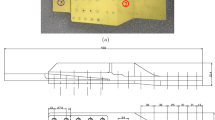Abstract
Aerospace alloys, often aluminums, are frequently exposed to corrosive environments resulting from naval service. These environments may produce significant changes in crack growth characteristics in these materials. An experiment was designed to characterize the effects of environment on crack growth thresholds and fracture characteristics for existing cracks in aluminum 7050-T7451 plate material. This data will be comparatively analyzed against aluminum 7075-T7631, an alloy with known susceptibility to corrosion, in order to determine a relative susceptibility of 7050-T7451, generally considered a superior aluminum alloy in terms of strength and corrosion resistance. The resulting data and subsequent analysis can in turn be used in more accurate determination of aircraft component service life in common corrosive environments experienced by aircraft in naval service.









Similar content being viewed by others
References
J. Schubbe, Evaluation of fatigue life and crack growth rates in 7050-T7451 aluminum plate for T-L and L-S oriented failure under truncated spectra loading, Eng. Fail. Anal., 2009, 16, p 340–349
J. Schubbe, Fatigue Crack Propagation in 7050-T7451 Plate Alloy, Eng. Fract. Mech., 2009, 76, p 1037–1048. doi:10.1016/j.engfracmech.2009.01.006
R. Braun, Environmentally Assisted Cracking of Aluminum Alloys, Mat.-wiss. u. Werkstofftech., 2007, 38(9), doi:10.1002/mawe.200700204
N. Holroyd, Environment-Induced Cracking of High-Strength Aluminum Alloys, Proceedings of the First International Conference on Environment-Induced Cracking of Metals, R.P. Gangloff, M.B. Ives, Ed., 1988, NACE-10, National Association of Corrosion Engineers, Houston TX, 1990, p 311–345
D. Sprowls, Fundamental Aspects of Stress Corrosion Cracking, R.W. Staehle, Ed., National Association of Corrosion Engineers, Houston, 1969, p 466
E. Hollingsworth and B. Hunsicker, Metals Handbook, Vol 13, 9th ed., ASM International, Metals Park, OH, 1987
ASTM Standard E399-08, “Standard Test Method for Linear-Elastic Plane-Strain Fracture Toughness KIC of Metallic Materials”, ASTM International, West Conshohocken, PA, 2008, www.astm.org
ASTM Standard E647-08, “Standard test method for measurement of fatigue crack growth rates,” ASTM International, West Conshohocken, PA, 2008, www.astm.org
S. Antolovich and B. Antolovich, ASM Handbook: Fatigue and Fracture, Vol 19, ASM International, Materials Park, OH, 1996, p 371–392
R. Gangloff, R. Piascik, D. Dicus, and J. Newman, Fatigue Crack Propagation in Aerospace Aluminum Alloys, J. Aircraft, 1994, 31, p 720–729
B.E. Wilde, ASM Handbook: Failure Analysis and Prevention, Vol 11, ASM International, Materials Park, OH, 1986, p 203–224
G. Koch, ASM Handbook: Fatigue and Fracture, Vol 19, ASM International, Materials Park, OH, 1996, p 483–506
Acknowledgments
The authors thank the Center for Corrosion Science and Engineering, United States Naval Research Laboratory, Washington, DC.
Author information
Authors and Affiliations
Corresponding author
Rights and permissions
About this article
Cite this article
Arnold, E.M., Schubbe, J.J., Moran, P.J. et al. Comparison of SCC Thresholds and Environmentally Assisted Cracking in 7050-T7451 Aluminum Plate. J. of Materi Eng and Perform 21, 2480–2486 (2012). https://doi.org/10.1007/s11665-012-0204-5
Received:
Revised:
Published:
Issue Date:
DOI: https://doi.org/10.1007/s11665-012-0204-5




